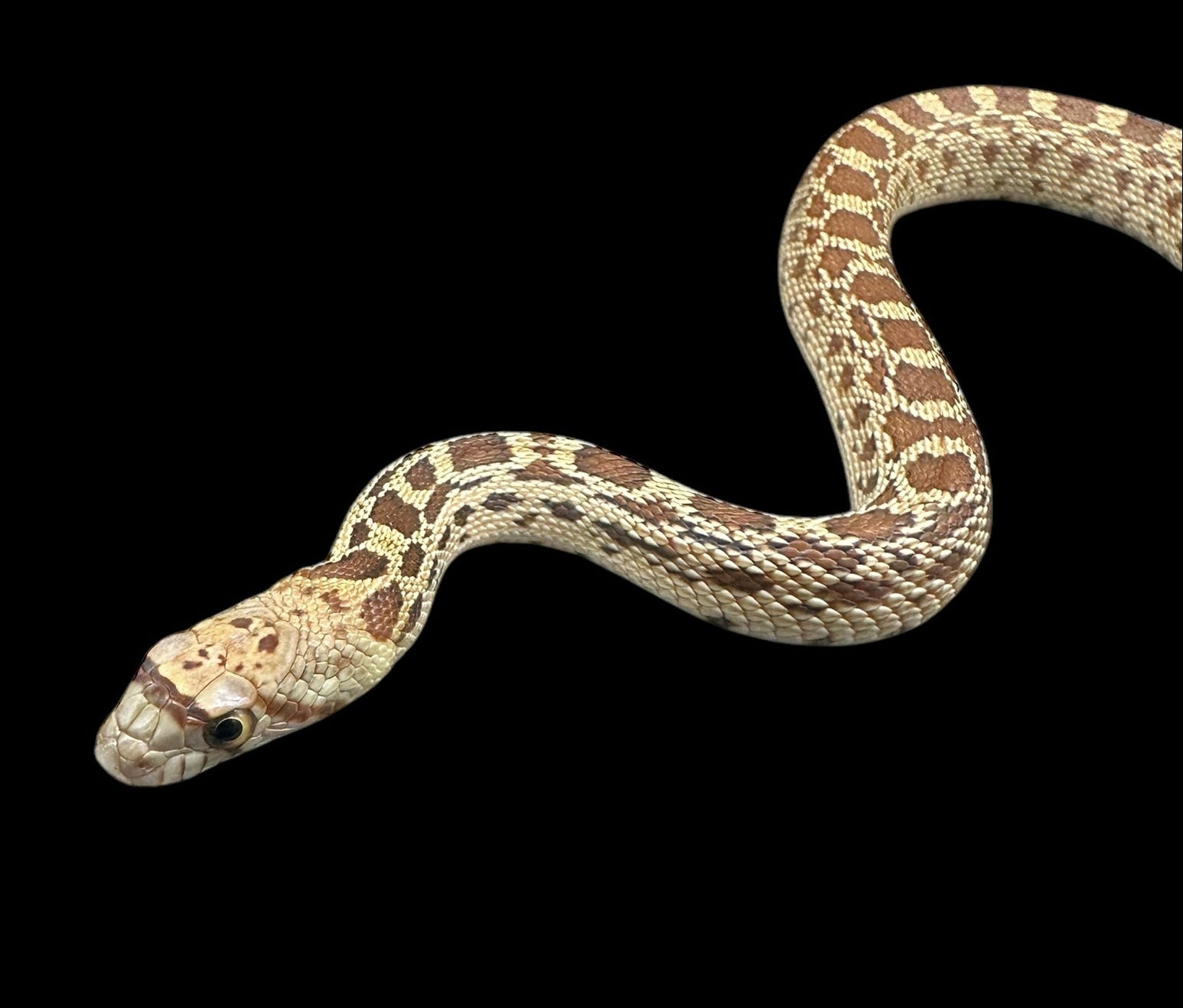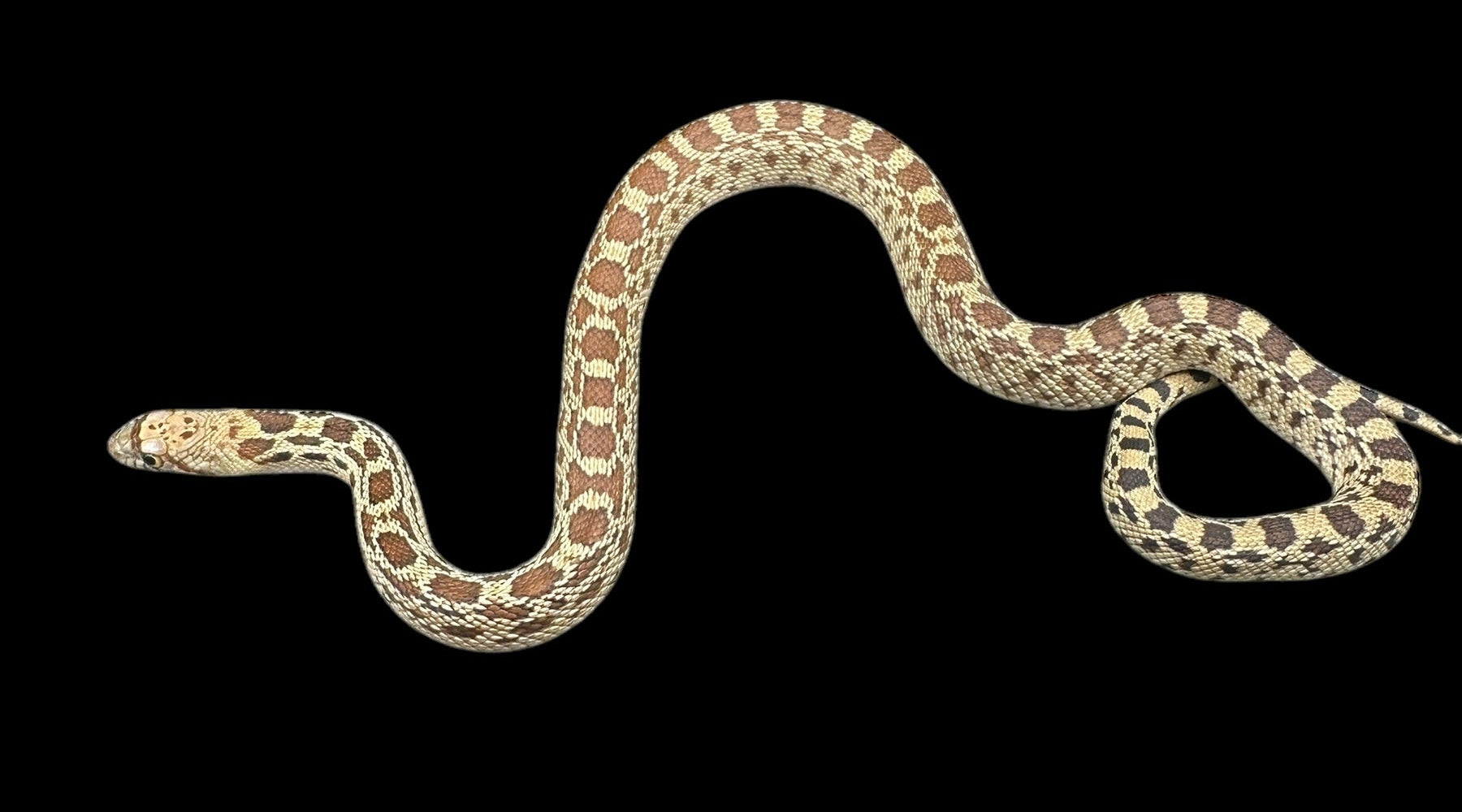Photo Disclaimer
Description
Sonoran Gopher Snake (Normal)
Scientific Name: Pituophis catenifer affinis
Common Name: Sonoran Gopher Snake
Species Overview
Size: Adult Sonoran Gopher Snakes typically reach 4–6.5 feet (1.2–2.0 m) in length; in rare cases, they may approach 7 feet (2.1 m). They are strong, medium-to-large constrictors with keeled scales, a pointed snout, and an athletic build well adapted to desert life.
Appearance: The Normal Sonoran Gopher Snake displays the classic desert colouration of the subspecies, featuring a golden to sandy-yellow base with dark brown or black dorsal blotches running down the body. The sides are marked with smaller, alternating spots, and the head exhibits bold dark lines between and behind the eyes—typical of the Pituophis genus. This subspecies often shows richer yellows and higher contrast compared to northern Gopher Snake populations, reflecting adaptation to the bright, arid environments of the Sonoran Desert. The result is a striking, naturally beautiful snake that captures the essence of the Southwest.
Distribution: Found throughout the southwestern United States and northern Mexico, including Arizona, New Mexico, western Texas, and the Mexican states of Sonora and Chihuahua.
Habitat: In the wild, Sonoran Gopher Snakes inhabit deserts, rocky hillsides, and dry grasslands with sandy or loose soil suitable for burrowing. In captivity, they thrive in spacious terrestrial enclosures with dry substrate, open basking areas, and secure hides that mirror their natural environment.
Behaviour: Sonoran Gopher Snakes are intelligent, diurnal constrictors known for their alertness and curiosity. In the wild, they are often mistaken for rattlesnakes due to their defensive hissing and tail-vibrating displays, but in captivity, they are typically calm, confident, and engaging once accustomed to handling.
Captive Care
Enclosure: Provide an adult enclosure at least 4 feet × 2 feet × 2 feet, though larger setups are always beneficial. Use dry, loose substrate such as aspen, soil-sand blend, or coconut husk to allow burrowing. Include multiple hides, rocks, and climbing branches for enrichment.
Temperature & Humidity: Maintain a daytime gradient of 78–86°F (25–30°C) with a basking area near 90°F (32°C). Allow nighttime drops to 68–72°F (20–22°C). Keep humidity between 30–45%, increasing slightly during shedding.
Diet: Offer thawed rodents proportional to the snake’s girth—juveniles every 5–7 days and adults every 10–14 days. Sonoran Gopher Snakes are strong, dependable feeders and rarely refuse meals.
Behaviour in Captivity: Active, alert, and hardy, Sonoran Gopher Snakes adapt well to captive conditions. They thrive with regular handling and environmental enrichment, becoming confident, interactive animals that display natural behaviours in a properly set-up enclosure.
Special Considerations: Due to their strength and curiosity, ensure all enclosure lids are secure. Their strong feeding response makes tongs recommended during feeding to prevent accidental strikes.
Genetics Note
The Normal Sonoran Gopher Snake represents the wild-type form of Pituophis catenifer affinis, showing the full natural range of colour and pattern typical of the subspecies. While not a morph, the Normal form serves as the genetic foundation for all selectively bred lines such as Albino, Rusty, and Snow. Naturally occurring regional variations exist, with desert populations tending toward brighter yellows and higher contrast than their more northern relatives.
Genetic Combination Summary
The Sonoran Gopher Snake (Normal) expresses the wild-type appearance of its subspecies:
-
Wild-Type Pattern: Sandy-yellow base with dark dorsal blotches and smaller lateral markings.
-
Genetic Role: Serves as the foundation for morph development and locality-based breeding projects.
Highly sought after by locality enthusiasts and keepers of natural lines, the Normal Sonoran Gopher Snake embodies the rugged beauty and adaptability of desert Pituophis. Its striking natural contrast, intelligence, and hardy temperament make it both a rewarding display species and an essential cornerstone in breeding programs.


